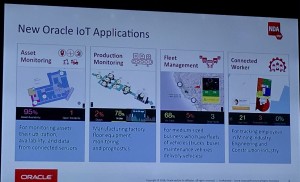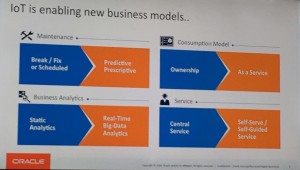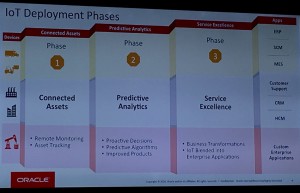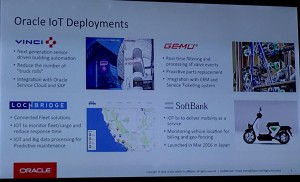Many companies approach the internet of things by starting with a device, make it connectable and then are in search of a business use case. This is a typical process that happens when there is a new area of technology area. If a company uses that as a strategy, it can be the long road to #IoT innovation. What businesses need to ask themselves are, “What business outcomes are they looking for and what innovations could be possible to shift their business model?”
We heard from the @OracleIOT group several business scenarios:
- Break / Fix it – which drives a predictive prescriptive business process
- Static Analytics – which drives the use of real-time, big-data analytics
- Ownership – which drives as-a-service business models and
- Central Service– which drives self-service as well as self-guided service.
What they are finding is that there are various phases a business often goes through when deploying IOT. It can start with the devices or assets (trucks, phones, factories, etc…) which are then connected to a platform which are connected to a network. For a business to actually make use of IOT, the first phase, Phase 1 can be about Connecting Assets for situations like remote monitoring and asset tracking. Phase 2 is can be using Predictive Analytics which means designing predictive algorithms to transform decisions into proactive instead of reactive decisions and improving products and processes. Phase 3 can be about Service Excellence. This is where the customer or employee experience is affected. It is where IOT is being used to transform business processes by blending IOT into enterprise applications like ERP, SCM, Customer Support, CRM, HCM…
Some of Oracle’s IOT applications are in the areas of:
- Asset monitoring for the utilization, availability and data from connected sensors
- Production monitoring and prognostics of the equipment on the manufacturing factory floor
- Fleet Management for business who have fleets of trucks, buses, delivery and maintenance vehicles
- Connected worker for the tracking of employees, for instance in the mining, engineering construction industries.

Here are some examples of clients applying IOT to their businesses:
VINCI is building the next generation sensor-driven building automation to reduce the number of “truck rolls” which has a huge ROI. They are doing this with the integration or Oracle Service Cloud and SAP. Lochbridge is creating connected fleets where IOT and big data is being used for predictive maintenance in monitoring fleet / cargo to reduce the response time. GEMU is using real-time filtering and processing of valve events and proactive parts replacement with the integration of CRM, IOT and a service ticketing system. And SoftBank is using IOT to deliver mobility-as-a-service where they are monitoring vehicle location for billing and geo-fencing.
As the world of IOT expands and more and more companies start to see the value in connecting enterprise applications, with devices, and networks, we will see the transformation of workers, employees and customer experiences. When those experiences are transformed, the real value and ROI of the connected enterprise will come to life.
@DrNatalie Petouhoff, VP and Principal Analyst
Constellation Research, Covering Customer Facing Applications and IOT





